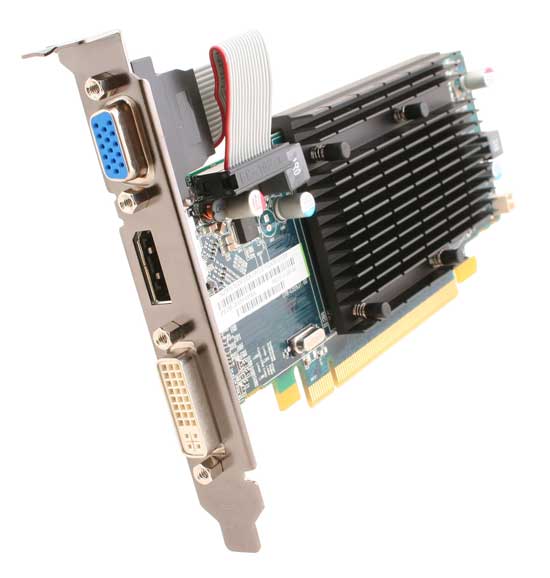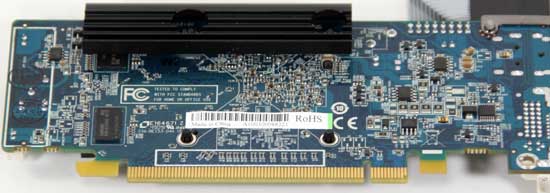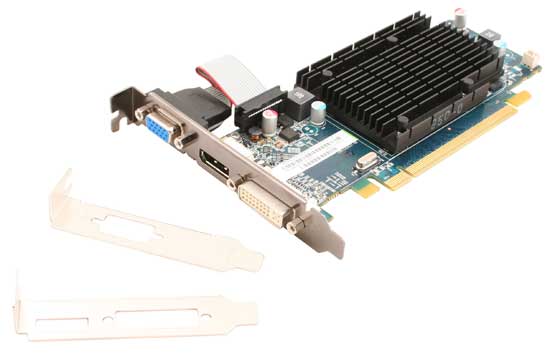AMD’s Radeon HD 5450: The Next Step In HTPC Video Cards
by Ryan Smith on February 4, 2010 12:00 AM EST- Posted in
- GPUs
Meet the Sapphire 5450
Along with our reference card from AMD, Sapphire also sent in their near-reference 5450. As it was clocked correctly at 650MHz/800MHz, we were able to use this card to benchmark the 5450 at its proper clocks, so we’d like to thank Sapphire for sending this in.

The Sapphire 5450 is nearly identical to AMD’s reference card. It uses the same PCB and the same port configuration, and the RAM chips are the appropriate 800MHz Samsung DDR3 chips. The key difference between the two cards is that while AMD is using a double-wide heatsink, the Sapphire 5450 is using a smaller single-wide heatsink. This means that the Sapphire 5450 will fit in to cases where only a single slot’s worth of space is available below the card.

However on the flip side (in all senses of the word) Sapphire’s heatsink wraps around the card slightly, which results in it sticking up from the back side of the card. Technically speaking the heatsink is encroaching on the space that belongs to the card above it, so the Sapphire card won’t fit if there’s a card more than 2 inches long in the slot above it, or if there are tall motherboard components there. In our case it encroached on the audio riser card for our Rampage II Extreme Motherboard. This shouldn’t be a problem for the vast majority of users and is more compatible than a card with a double-wide heatsink, but nevertheless check your case to make sure there’s room for the heatsink on the back side of the card.

As is usually the case with bottom-tier cards, Sapphire packs the 5450 with very little. It comes with a driver CD, the low-profile brackets for the card (it ships with the full-profile bracket installed), an instruction manual, and ArcSoft’s SimHD plugin for upconverting video conferencing feeds. Surprisingly, all of this comes in a full-sized box – this is the first sub-$100 card we’ve seen in some time to not come in a mini-box.
Sapphire also sent along their entire 5450 product chart. Of note, they will be releasing DDR2 and DDR3 cards with HDMI ports that are otherwise identical to today's DisplayPort card, so HTPC users will not be left out in the cold.










77 Comments
View All Comments
andy o - Thursday, February 4, 2010 - link
So far the most reasonable explanation I've seen by googling is someone if a forum suggesting that its function is just disabling certain features so as to prioritize smooth playback over those features. I don't see any difference with the 5770, otherwise (with that card it doesn't disable anything).UNCjigga - Thursday, February 4, 2010 - link
I sort of assumed it was similar to what 120hz/240hz LCD TVs do: use a frame doubler to more closely match your monitor's refresh rate and give the impression of "smooth" motion.andy o - Thursday, February 4, 2010 - link
I don't think so, most PC displays are 60 Hz, and I think even most 120 Hz TVs only take up to 60p input. There's only a couple of 120Hz-input monitors.therealnickdanger - Wednesday, February 10, 2010 - link
Actually, most CRTs using analog connections are capable of 120Hz. DVI, HDMI, and DisplayPort do not support digital transmission speeds over 60Hz. It's a sad state of affairs if you ask me.sc3252 - Thursday, February 4, 2010 - link
I know this isn't exactly supposed to be a fast card, but its clocked ~10% faster yet its slower than the last generation card... I can't say I am surprised though, after seeing the 5770 clocked faster than the 4870 yet being around the same speed.StevoLincolnite - Thursday, February 4, 2010 - link
I think people are missing allot of the big picture here and that's Crossfire with the Radeon 54xx series.Specifically with the new 8 series of chipsets, hence the amount of shaders present, I expect a return of Hybrid Crossfire.
Pairing an IGP with a low-end card is a very cost effective solution to getting more performance out of a system and also gives AMD an edge in getting more people to buy an AMD Processor+Chipset+Graphics card.
ereavis - Thursday, February 4, 2010 - link
"me too" I'd dig a 758G Hybrid Crossfire review with this and the other sub $100 Radeons (if they support x-fire) 785 was a great motherboard to match with the Athlon II and Phenom II X2-X3, some of us were waiting on video card purchases and would like to see Crossfire 54XX/56XX compared to a 5750 discrete for example.JarredWalton - Friday, February 5, 2010 - link
Fun fact: HD 5450 is about 40% faster than my pathetic old 7600 GT in my work PC. Remember when 6600 GT was da bomb? LOLQuietOC - Thursday, February 4, 2010 - link
The 80 shader discrete Radeons are just too limited by 64-bit DDR3. The 785G has more bandwidth and the same number of ROPS (mine even runs fine at 1GHz.) If they had cut the power usage of the 5450 down a lot more it may have made some sense.Totally - Thursday, February 4, 2010 - link
5770 128-bit bus, 4870 256-bit busagain 5450 64-bit bus, 4550 128-bit bus